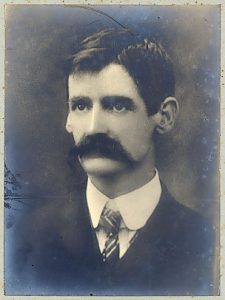On 17th June it will be Australian poet and short story writer Henry Lawson’s 150th birthday. There will be parties, exhibitions and talks in Sydney and Grenfell to honour this anniversary. The best way I can mark this date is by discussing a Henry Lawson poem.
The Statue of our Queen by Henry Lawson

Photograph of Henry Lawson, circa 1902, showing his remarkable eyes, which were said to see right into the hearts of men and women.
PRIDE, selfishness in every line,
And on its face a frown,
It stands, a sceptre in its hand,
And points forever down.
And who will kneel? The unemployed!
Small homage pay, I ween,
The only men who gather ’neath
The Statue of our Queen.
I’d scarcely wonder if the sun,
That rises with good grace,
Should sink and leave the day undone
At sight of such a face.
But no! The day will still have birth
In all its golden sheen,
When antiquarians unearth
The Statue of our Queen.
Then if you’d have us loyal bide
As we have loyal been,
Great Parkes! for love of England, hide
The Statue of our Queen.
Lawson was an avid Republican and felt Australia would be far better off without Britain. He argued that Aussie history should be taught in schools, that some Australian literature should also be included in the syllabus, and he despised what he called “Australian groveldom” towards England. In his view, Australia should be “the Great Republic of the Southern Seas”.
In 1887 Queen Victoria’s Golden Jubilee celebrations were celebrated with fervour around the country. Special coins were produced at the Sydney Mint, but Lawson was not alone in hating such celebrations. Public meetings were held, there were some riots in the streets and republicans twice defeated attempts at the Sydney Town Hall to pass a loyal resolution congratulating the Queen on her 50 years on the throne. A statue of the Queen was unveiled in Queen’s Square by the Governor’s wife in January 1888. There had been one in Sydney’s Garden Palace, but that burned along with the building in 1882. Queen’s Square was once much grander, and took up considerable space at the top of Macquarie Street. The statue soon proved to be in the way when trams were introduced and had to be moved, and then moved again. Henry Lawson would probably have felt happy at the undignified fate of both statues.
His poem expresses his contempt for this royal personage. She does not care about the city’s unemployed, and he implies that she looks down on Australia. He writes of her pride and selfishness which must surely be visible to everyone who looks at the statue. Henry Parkes was an ardent royalist and Lawson addresses him directly in the poem, advising him to hide the statue away.
The poem was first published in 1890. It is very topical – Australia is still debating republicanism and the role of the monarchy in this country today.
Share your thoughts on this poem by leaving a comment.
Selected links for relevant websites, books, movies, videos, and more. Some of these links lead to protected content on this website, learn more about that here.

Beatrice Yell
On arrival in Liverpool in 1958 I saw a similar statue atop a men’s toilet. Beatrice
Susannah Fullerton
Good grief! I hope she was keeping an eye on proceedings.
Helen
I love the word “groveldom” – perhaps a little like ‘woke’ with so many going along with the tide of feelings without acknowledging the bigger picture.
Susannah Fullerton
It’s a very evocative word, isn’t it.
Michael Williams
Never realized such convict colony republican refuse was so early abroad/permitted in Australia.
Susannah Fullerton
I think such views got you into trouble, but they were certainly around.
Suzanne Williams
Very interesting background on the old debate of monarchy versus republicanism .
Thank you.
Susannah Fullerton
Glad you liked it, Suzanne.